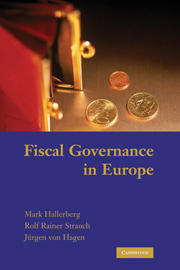Book contents
- Frontmatter
- Contents
- Acknowledgments
- 1 INTRODUCTION
- 2 ELECTORAL AND FISCAL INSTITUTIONS AND FORMS OF FISCAL GOVERNANCE
- 3 AN ACCOUNT OF FISCAL NORMS AND RULES IN THE EUROPEAN UNION FROM 1985 TO 2004
- 4 HOW FORMS OF FISCAL GOVERNANCE AFFECT FISCAL PERFORMANCE
- 5 WHY DO COUNTRIES HAVE DIFFERENT FISCAL INSTITUTIONS?
- 6 INSTITUTIONAL CHOICE IN NEW DEMOCRACIES: FISCAL GOVERNANCE IN CENTRAL AND EAST EUROPEAN COUNTRIES
- 7 EMU AND FISCAL GOVERNANCE IN EUROPE
- 8 CONCLUSION
- Bibliography
- Index
- Cambridge Studies in Comparative Politics
6 - INSTITUTIONAL CHOICE IN NEW DEMOCRACIES: FISCAL GOVERNANCE IN CENTRAL AND EAST EUROPEAN COUNTRIES
Published online by Cambridge University Press: 04 August 2010
- Frontmatter
- Contents
- Acknowledgments
- 1 INTRODUCTION
- 2 ELECTORAL AND FISCAL INSTITUTIONS AND FORMS OF FISCAL GOVERNANCE
- 3 AN ACCOUNT OF FISCAL NORMS AND RULES IN THE EUROPEAN UNION FROM 1985 TO 2004
- 4 HOW FORMS OF FISCAL GOVERNANCE AFFECT FISCAL PERFORMANCE
- 5 WHY DO COUNTRIES HAVE DIFFERENT FISCAL INSTITUTIONS?
- 6 INSTITUTIONAL CHOICE IN NEW DEMOCRACIES: FISCAL GOVERNANCE IN CENTRAL AND EAST EUROPEAN COUNTRIES
- 7 EMU AND FISCAL GOVERNANCE IN EUROPE
- 8 CONCLUSION
- Bibliography
- Index
- Cambridge Studies in Comparative Politics
Summary
The first four chapters concentrated on the design and effect of forms of fiscal governance in the countries that composed the European Union until 2004. The fifth chapter discussed why those countries adopted the fiscal institutions that they did. The focus was on the effects of deep fiscal crises, the competitiveness of the political system, and ideological distances within the government, which affect the choice of one form of fiscal governance or the other. Here we broaden the study to include the Central and Eastern Europe countries that joined the EU in May 2004, the Czech Republic, Estonia, Hungary, Latvia, Lithuania, Poland, Slovakia, and Slovenia, as well as Bulgaria and Romania, which became members in January 2007.
This is a particularly interesting sample for our purposes. Government budgeting in the sense the term is used in modern, market economies did not exist under central planning, and the countries we consider had to create new legal frameworks, organizational modes, and decision-making structures from scratch. This makes the sample uniquely interesting for a study of institutional choice, because, unlike in the countries considered in the previous chapter, the weight of history and tradition in shaping the new institutions is very low. At the same time, we observe a fair degree of variation across the budgeting institutions of the countries. This raises the question of how the variation can be explained.
This chapter begins with a discussion of the evolution of budgeting institutions in the ten sample countries.
- Type
- Chapter
- Information
- Fiscal Governance in Europe , pp. 139 - 169Publisher: Cambridge University PressPrint publication year: 2009

